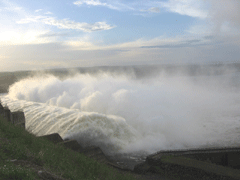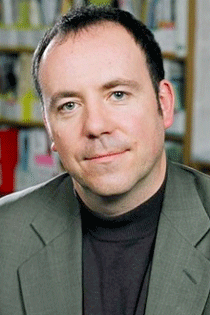Damming the Developing World
Air Date: Week of May 23, 2008

Tucurui dam in Brazil. (Courtesy of International Rivers)
While interest in building hydro-electric dams is waning in the United States, developing nations are increasingly turning to their rivers to power their growing economies. Hydropower is finding financial help from China and carbon offset traders, but critics question the environmental and societal advantages of large-scale dams. Host Bruce Gellerman talks with International Rivers Director Patrick McCully about dams in the developing world.
Transcript
GELLERMAN: Well the World Bank used to finance many big dam projects, but citizen action and environmental concerns have changed that policy. Yet many developing nations still see hydropower as an untapped renewable source of clean energy. International Rivers monitors dam building around the world. Patrick McCully is executive director of the conservation group, and he says there’s no shortage of cash to fund big dam projects.
MCCULLY: What’s happened is that countries like Brazil, India, China, now they have a lot more of their own resources so they don’t need international money so much, and one other really major factor in dam building around the world at the moment is that China actually is going around the world and writing checks for big dams without any types of environmental or social policies, and in many ways replacing the role that the World Bank and other Western funders used to play.

Brazil first proposed damming the Xingu River in the Amazon Basin in the 1970s. After canceling previous plans, it now plans to build the Belo Monte Dam, what could be the world’s third largest dam when built.
Credit: (Courtesy of International Rivers)
MCCULLY: Partly it’s promoting their own industries. So when China is funding, for example, a big dam in Sudan that they’ve been building which is very controversial, and their Chinese construction companies get all the contracts, so that’s an obvious reason for the Chinese to want to promote it. But there’s also geopolitical reasons. So, again, use Sudan as the example, China is very keen to have good relations with Sudan because they want to get Sudanese oil, so building a dam is a good way of cementing relationships.
GELLERMAN: It’s ironic that worldwide there’s this resurgence of dam building, and yet here in the United States, there are a lot of river restoration projects and the removal of dams, going back to, well, about 1999.

Tucurui dam in Brazil. (Courtesy of International Rivers)
GELLERMAN: Yeah, I understand that would be the largest dam in the world – much bigger than the Three Gorges Dam in China.
MCCULLY: Yea, by far, more than twice as big as Three Gorges Dam, and with a price tag several times as big, being built in one of the most unstable and conflict-ridden and corrupt countries in the world. The record of these big projects is that they spark off lots of corruption and can lead to conflict of various types.
GELLERMAN: What role, if any, do carbon offsets play in the construction of dams – that is, if they build a dam, they get credit towards polluting carbon dioxide in other places?

Patrick McCully, executive director of International Rivers, says large hydropower dams can emit as much greenhouse gases as coal plants.
(Courtesy of International Rivers)
GELLERMAN: But Mr. McCully, what’s wrong with a dam? I mean, they don’t emit greenhouse gases, they do produce electric power – what’s wrong with that?
MCCULLY: Well, biggest problem usually is these big dam projects is that they displace huge numbers of people and cause great harm to their livelihoods. When you build these great mega-projects, their power lines go off to the cities and the mines and the industries, and they don’t provide benefits to local communities, and they do great harm to riverine ecosystems. But beyond that, the argument that they are by their nature climate friendly is very simplistic. In fact the big reservoirs in the tropics can have very large greenhouse gas emissions, because basically flooded vegetation and soils, and that produces methane, and that’s a very powerful greenhouse gas. So the big Amazonian reservoirs, for example, can have much higher global warming impact than fossil fuels, even than coal plants.
GELLERMAN: I’m wondering, personally, you know, you’re up against some of the biggest corporations and countries in the world. Do you ever feel like that little Dutch boy with the finger in the dike, you know, trying to hold this thing back?
MCCULLY: (chuckles) Yeah, sometimes it’s – sometimes it’s easy to feel a bit overwhelmed, but at the same time we have a great global network of organizations that we work with. There’s also in the rise of renewable energy, falling price of solar, the increasing feasibility of wind power in many places. So the clean energy alternatives are much more viable that they used to be, which is a great thing for us.
GELLERMAN: Well, Mr. McCully, thanks very much. I appreciate it.
MCCULLY: It’s a pleasure.
GELLERMAN: Patrick McCully is executive director of the conservation group International Rivers.
Links
Living on Earth wants to hear from you!
Living on Earth
62 Calef Highway, Suite 212
Lee, NH 03861
Telephone: 617-287-4121
E-mail: comments@loe.org
Newsletter [Click here]
Donate to Living on Earth!
Living on Earth is an independent media program and relies entirely on contributions from listeners and institutions supporting public service. Please donate now to preserve an independent environmental voice.
NewsletterLiving on Earth offers a weekly delivery of the show's rundown to your mailbox. Sign up for our newsletter today!
 Sailors For The Sea: Be the change you want to sea.
Sailors For The Sea: Be the change you want to sea.
 The Grantham Foundation for the Protection of the Environment: Committed to protecting and improving the health of the global environment.
The Grantham Foundation for the Protection of the Environment: Committed to protecting and improving the health of the global environment.
 Contribute to Living on Earth and receive, as our gift to you, an archival print of one of Mark Seth Lender's extraordinary wildlife photographs. Follow the link to see Mark's current collection of photographs.
Contribute to Living on Earth and receive, as our gift to you, an archival print of one of Mark Seth Lender's extraordinary wildlife photographs. Follow the link to see Mark's current collection of photographs.
 Buy a signed copy of Mark Seth Lender's book Smeagull the Seagull & support Living on Earth
Buy a signed copy of Mark Seth Lender's book Smeagull the Seagull & support Living on Earth

